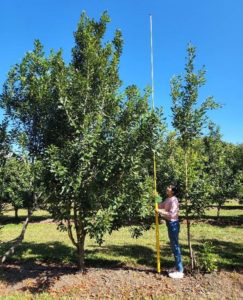
Exploring the genetics and physiology of scion vigour in macadamia, TropAg
October 19, 2022
The Crawford Fund’s Queensland Committee has again partnered with the TropAg International Agriculture Conference to assist 10 young researchers from developing countries attend and present their science at this international conference which will be held in Brisbane from 31 October to 02 November 2022.
Successful candidates were chosen by a selection panel made up of representatives of The Crawford Fund and the TropAg conference organisers, based on submitted abstracts of their research.
In the lead-up to the conference we will be publishing short blog posts written by the young researchers about their work. Here is the fifth blog.
By Pragya Dhakal Poudel, The University of Queensland

Belonging to an agricultural country, Nepal, contributing towards agricultural development through research has always been my goal. Moving forward to achieve this goal, I am currently pursuing a PhD (2nd year) with the Queensland Alliance for Agriculture and Food Innovation, at The University of Queensland. I am very thankful to the Crawford Fund for supporting me in this journey by providing me with a scholarship to present a part of my PhD research at TropAg2022 annual conference.
Genetics, physiology, and molecular biology are important aspects of crop breeding and bringing these components together, my project is focusing on “Exploring the genetics and physiology of scion vigour in macadamia”.
High tree vigour at maturity is the key obstacle of high-density planting in commercialised macadamia orchards, causing orchard crowding, shading, and obstructing growers with machinery access for management practices. To address this high vigour, intensive topping, pruning, and hedging are undertaken which is found to cause dramatic yield decline. My research therefore focuses on identifying dwarfing rootstocks and low vigour cultivars for efficient management and increased profitability of the commercial orchards.
To identify dwarfing rootstocks, I evaluated the effect of 24 rootstocks on the growth of a common scion, in a trial planted at the Maroochy Research Station, Nambour.Addressing my next research question: how rootstocks affect tree growth, I will be studying a range of physiological traits and compare rootstocks with different degrees of vigour imparting capabilities to understand the physiology of rootstock mediated vigour control. In addition, I will also be exploring aquaporin gene activities and differential expressions to elucidate any role in vigour control mechanism.
Selection for low vigour cultivars is another option that could aid high-density orchards. However, selection process in breeding program is lengthy and laborious due to high heterozygosity, long juvenility, and long time to maturity. This project thus focuses on performing genomics assisted breeding through genome-wide association studies, QTL mapping and genomic selection for early and rapid selection of low vigour cultivars.
Summing up, my research is likely to provide important basis for accelerated selection of dwarfing rootstocks and low vigour cultivars for orchard improvement.





 0
0